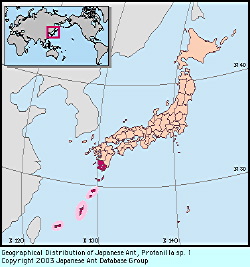
|
species
|
Protanilla sp.1
|
 |
Japanese Name
|
Juzufushi-ari
|
Description
|
|
Total length of workers around 2.5 mm. Color yellowish to reddish brown. Mandibles long and triangular, down-curved at apical 1/3; inner surface with peg-like setae. Antennal scape slightly exceeding posterior margin of head. Head about 1.3 times as long as broad. Mesosoma slender. Promesonotum weakly arched; metanotal groove deeply impressed. Propodeum almost the same size as pronotum; dorsal surface longer than declivity in profile. Petiole and postpetiole almost matching in size. Ventral portion of petiole rounded, with a small subtrapezoidal projection. First gastral segment large. Sting long, with a triangular structure apically and a small tooth subapically. Body surface almost smooth, shining, without sculpture.
|
Remarks
|
|
This species has been referred to as "Ponerinae ? sp." (Sonobe, 1972), "Gen. C sp. 1" [Japanese name: Okinawa-juzufushi-ari] and Gen. C sp. 2 [Senkaku-juzufushi-ari] of Myrmecological Society of Japan (1988). A colony collected from Seifaa-utaki, Okinawa I. in March contained one dealate female, 77 adult workers, 168 larvae and 17 eggs (Onoyama, unpublished). The postpetiole of the female is separated from the petiole by a marked constriction. A single, fused sternal plate, like that of Anomalomyrma, is not present. Found in Kyushu and the south, and also from Taiwan (Terayama, 1999). Not common.
|
|

Distribution
|
|
Kyushu (Mt. Kirishima [Rikio Sonobe leg.], Kagoshima), Nansei Is (Mt. Yuwandake, Amami-oshima I. [Hidetsune Takamine leg.]; Tokunoshima I.; Nakijin, Okinawa I. [Kazuki Tsuji & P. Jaisson leg.], Seifaa-utaki, Okinawa I. [Keiichi Onoyama leg.]; Uotsuri-jima I., Senkaku Is [Takuya Abe leg.]); Taiwan.
|
|
References
|
|
- Terayama, M. (1999). Family Formicidae. In Yamane, Sk., S. Ikudome & M. Terayama (eds.). Identification guide to the Aculeata of the Nansei Islands, Japan. Hokkaido University Press, pp. 138-317.
- Sonobe, R. (1972). Ant fauna of the Mt. Kirishima area. InIn M. Kato, ed., "Studies on the animal comunities in the terestrial ecosystems and their conservation". Annual Report of JIBP-CTS for the fiscal year of 1971. (pp. 176-182).
- Myrmecological Society of Japan, Editorial Committee (ed.) (Ed.). (1988). A list of the ants of Japan with common Japanese names. The Myrmecological Society of Japan, Tokyo.
|
Editor
|
|
Original text by Keiichi Onoyama and Kazuo Ogata. English translation by Kazuo Ogata, edited by Robert W. Taylor. Revised by Masashi Yoshimura.
|
|